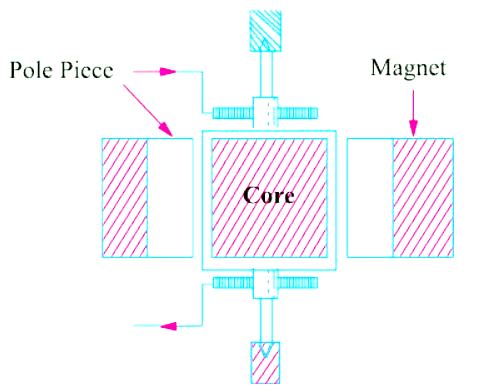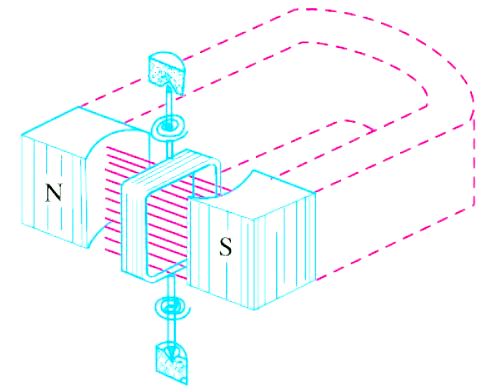Moving coil Instruments - Permanent Magnet Moving Coil
There are two types of Moving coil Instruments (i) Moving coil Instruments – permanent magnet moving Coil type (PMMC) which can be used for D.C. work only and (ii) Moving coil Instruments – Dynamometer type instrument which can be used both for A.C. and D.C. work.
Permanent Magnet Type Instruments:
The operation of a permanent-magnet moving-coil type instrument is be based upon the principle that when a current-carrying conductor is placed in a magnetic field, it is acted upon by a force which tends to move it to one side and out of the field.
Construction:
As its name indicates, the instrument consists of a permanent magnet and a rectangular coil of many turns wound on a light aluminum or copper former inside which is an iron core as shown in Figure A. The power full U-shaped permanent magnet is made of Alnico and has soft-iron end-pole pieces which are bored out cylindrically. Between the magnetic poles is fixed a soft iron cylinder whose function is
(i) to make the field radial and uniform and
(ii) to decrease the reluctance of the air path between the poles and hence increase the magnetic flux.
Surrounding the core is a rectangular coil of many turns wound on a light aluminum frame which is supported by delicate bearings and to which is attached a light pointer. The aluminium frame not only provides support for the coil but also provides damping by eddy currents induced in it.

The sides of the coil are free to move in the two airgaps between the poles and core as shown in Figure (A) and Figure (B). Control of the coil movement is affected by two phosphor-bronze hair springs, one above and one below, which additionally serve the purpose of lending the current in and out of the coil. The two springs are spiraled in opposite directions in order to neutralize the effects of temperature changes.
AdBlock-2

Deflecting Torque
When current is passed through the coil, force acts upon its both sides which produce a deflecting torque as shown in Figure (C). Let
B = flux density in Wb/m2
l = length or depth of the coil in metre
b = breadth of coil in metre

N = number of turns in the coil
If I ampere is the current passing through the coil, then the magnitude of the force experienced by each of its sides is = BIl newton For N turns, the force on each side of the coil is = NBIl newton
∴ deflecting torque Td = force × perpendicular distance
= NBIl × b = NBI(l × b) = NBIA N-m
where A is the face area of the coil.
It is seen that if B is constant, then Td is proportional to the current passing through the coil i.e.
Td ∝ I.
Such instruments are invariable spring-controlled so that Tc ∝ deflection θ.
Since at the final deflected position, Td = Tc
∴ θ ∝ I
Hence, such instruments have uniform scales. Damping is electromagnetic i.e. by eddy currents induced in the metal frame over which the coil is wound. Since the frame moves in an intense magnetic field, the induced eddy currents are large and damping is very effective.
Read article – Moving coil Instruments – Dynamometer type instrument
Visit NCERTplanet.com for NCERT solutions and Textbook downloads




